With the rise in tech jobs, more people are looking to become QA analysts. But before you take the plunge and start on such a career path, you might want to research what a quality assurance analyst does.
In the grand scheme, a good QA analyst is curious about technology, enjoys delving into the nitty-gritty, and is a natural problem solver. The job requires a lot of time to plan how to test computer software best and solve the problems that arise.
Becoming a QA Analyst might be right for you if you...
…are a stickler for detail
…aren’t afraid to critique other people’s work.
…have strong communication skills.
…have an interest in technology.
…love to solve problems.
What is QA?
Quality assurance is a system of testing that guarantees that the customer is given high-quality software free of critical errors. QA testers dream of releasing software free of bugs; however, they are a fact of life in software development. Like the development team, their goal is to release the highest quality product possible.
Every software company uses QA, from big tech giants such as Amazon and Google to small start-ups.
What Does a QA Analyst Do?
A QA analyst breaks things. They break things on purpose so the customer doesn’t break them by accident.
However, a QA analyst doesn’t break things recklessly. Quality assurance testing is a methodical process that requires planning, careful execution, and documentation.
QA testers play an important part in a product’s development. They ensure the final product meets the requirements set out by the client and reduce the number of errors in software. QA analysts are the first to encounter anything that might worsen the user experience.
After testing the software, a QA analyst will document any problems and send the report to the developers who revise the software. This development and testing cycle continues until the QA analyst (or team of QA analysts) is satisfied with the final product and gives it their stamp of approval. Once the QA analyst signs off on a product, it’s considered ready for release.
A QA analyst focuses on total quality management. Again, a QA analyst is a stickler for detail, a born problem-solver, and loves to maximize efficiency to sustain a high level of quality across the software development cycle. It’s not enough to test and break software (though it’s always satisfying when something breaks); a QA analyst also wants to optimize the process for testing and developing software. To do this, they work closely with other members of the quality assurance team.
In short, QA analysts are in both problem-solving and problem-prevention businesses.
What is QA Testing?
QA testing describes finding and fixing errors in the program’s code and documenting the process and cause of the error. It’s also concerned with the process behind software creation and seeks to isolate areas in the development cycle that can be improved and optimized.
There are many different strategies involved in QA testing. For example, the Capability Maturity Model Integration (CCMI) was developed by the software engineering division at Carnegie Mellon University. It is based on the principle that “the quality of a system or product is highly influenced by the process used to develop and maintain it.”
The CMMI model ranks the maturity of areas within an organization and identifies other areas that can be improved upon. The maturity level of an area is decided by how optimized the current development process is. A maturity level of one indicates that the process is not well optimized – often unpredictable and uncontrolled.
In contrast, a maturity level of five indicates that the process is predictable, well-controlled, stable, and needs only minor revisions for full optimization.
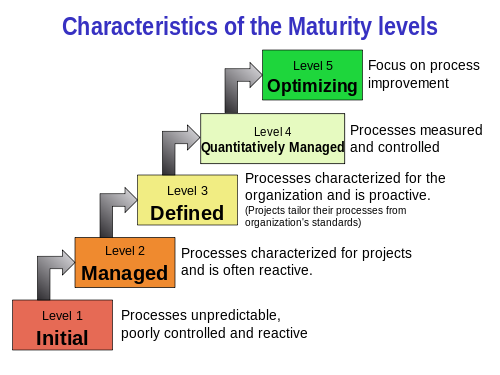
One popular tool QA testers use is Selenium, a free browser testing software that can be used across many browsers and platforms. The program was created by Jason Huggins, who, at the time, was frequently working on web applications that often required testing. While running these tests, he noticed that manual testing was inefficient. Frequently, he’d spend his days running the same tests repeatedly. It was so repetitive that even a robot could do it. So, he created a script that would automatically run the tests. Eventually, this grew into Selenium.
Some of Selenium’s key features include:
- Full support of multiple programming languages, including Java, Python, C#, Ruby, and PHP.
- Support of both iPhone and Android testing
- It can simulate key presses and other keyboard actions.
Most QA and IT companies will eventually use Selenium to automate their web testing. One of Selenium’s most attractive features is its ease of use. When introduced, it immediately leaped over many other tried and true testing techniques and became the go-to tool for web automation testing. Recruiters often look for people who are well-versed in the tool.
QA Analyst Day-to-Day
The day-to-day work of a QA analyst will vary depending on the software, where it is in the development cycle, and the structure of the organization they work for. Here’s an example of a recent job posting for a QA analyst.
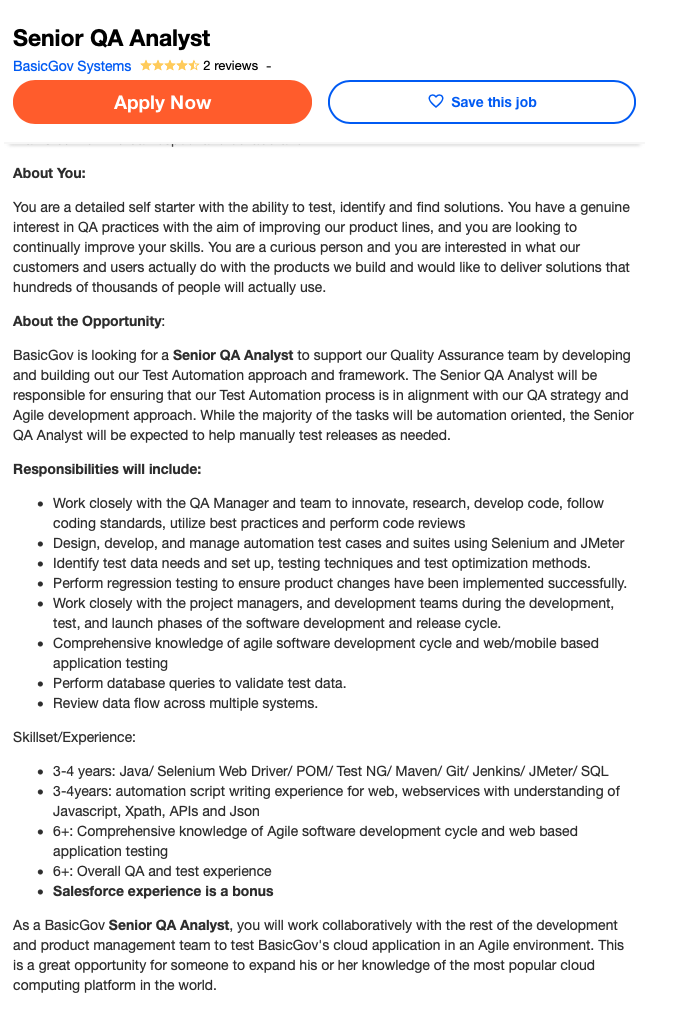
All jobs will require applicants to know several programming languages, demonstrate an ability to develop strategies for testing software and work closely with other QA teams.
Over at Gossamer-Threads, Mike Wu has broken down his day as a QA analyst in half-hour increments. He spends the first two hours testing the most important tickets in his queue before taking lunch. After having something to eat, he spends the rest of his day continuing on those test tickets before leaving himself a list of things to do the next day.
QA Analyst Jobs & Salary
QA Analyst Jobs
The future of QA analyst jobs looks good. With the tech and software industries experiencing an extended period of growth there are more and more jobs opening up for QA analysts. In 2017, the Stack Overflow Blog identified QA as one of the fields with the highest demand and lowest supply.
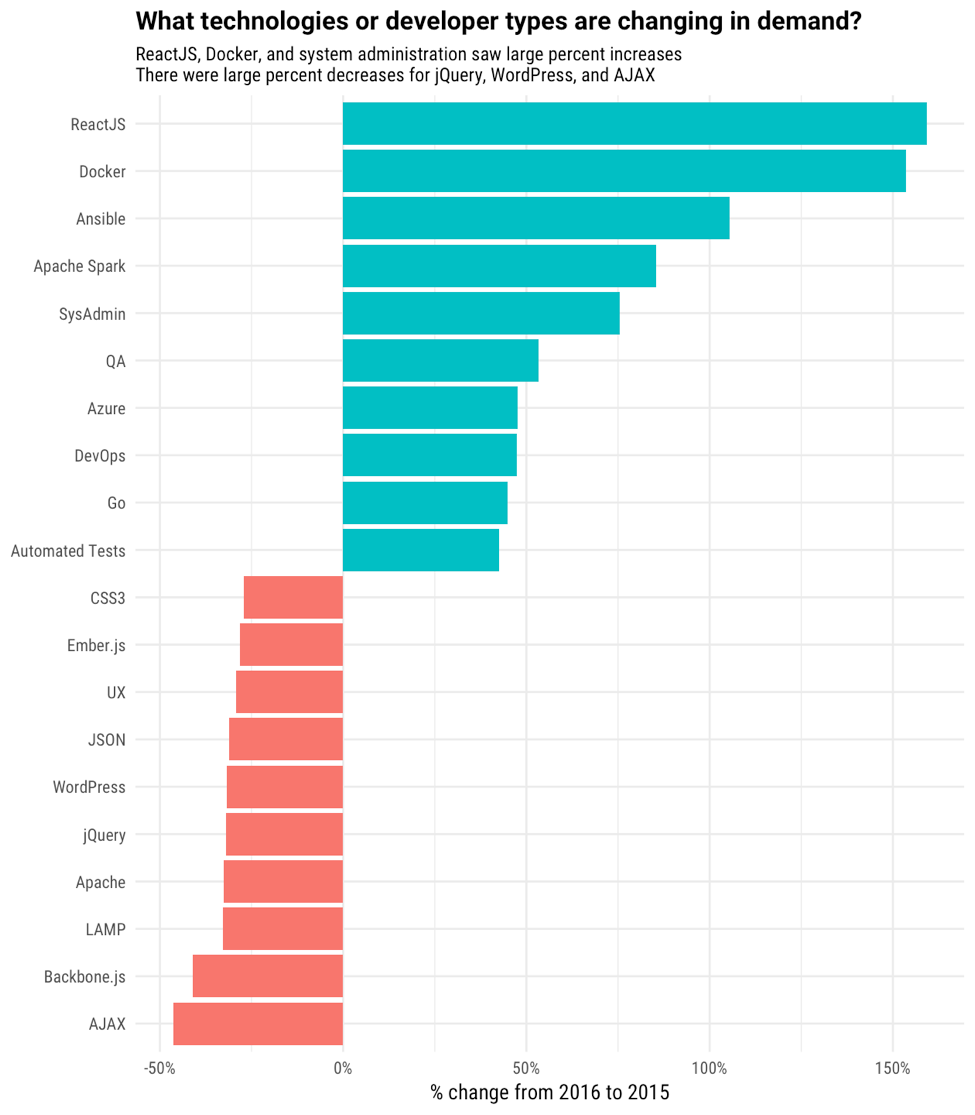
QA analyst jobs are in high demand and low supply and are predicted to become more in demand as the tech industry continues to grow. This is a wonderful cocktail of positives for prospective QA analysts. By becoming a QA analyst, you’ll have a wide range of interesting companies and technologies from which to choose.
The good news continues for QA analysts, as a Forbes survey listed senior QA analysts as having the second happiest job in the country.
QA Analyst Salary
This leads us to the topic of QA analyst salary. As you might’ve guessed, a career that’s high in demand and low in supply comes with a good salary. The average QA analyst makes $72,750/year, well above the national average salary of $31,009.
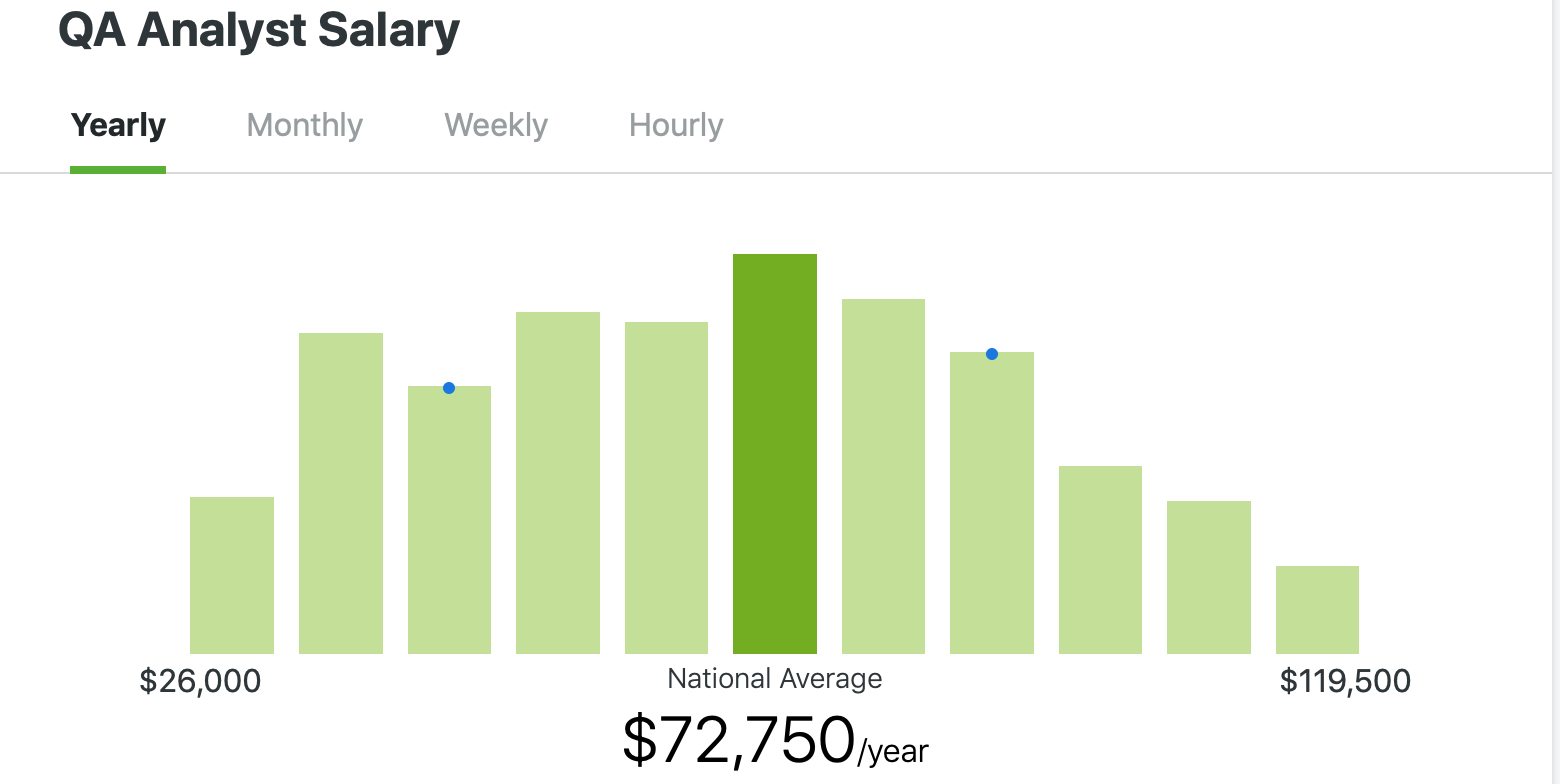
Many QA analysts become QA managers or lead software specialists, leading to another significant salary bump.
How Do I Become a QA Analyst?
So now that you’ve read a bit about what the day-to-day of a QA analyst is like and seen the career potential, you want to know how to become a QA analyst. Fortunately, the career path is fairly straightforward.
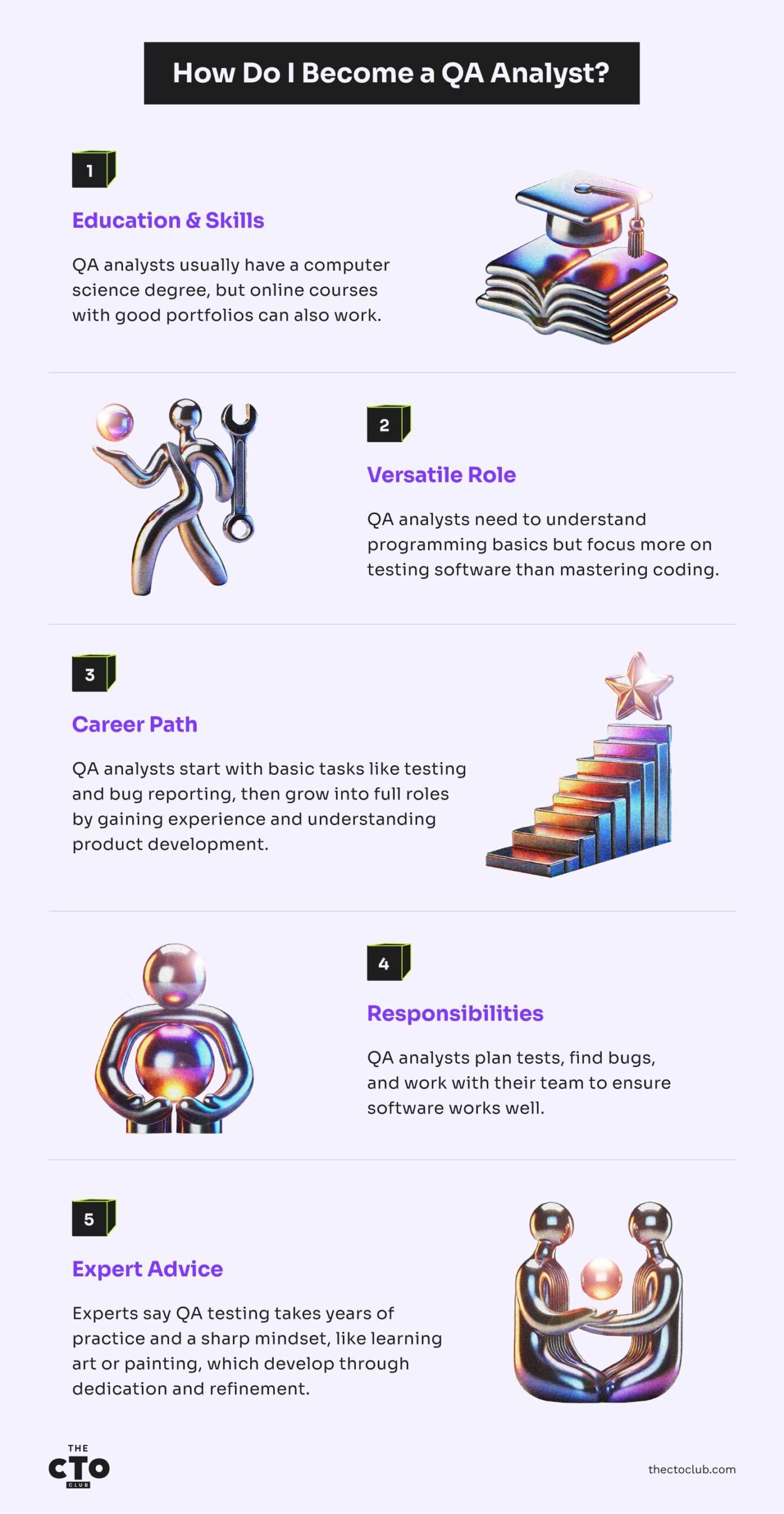
What Education Does a QA Analyst Need?
Most QA analysts have a bachelor’s degree in computer science or computer programming. QA analysts must have a deep understanding of the tools they're using to test software, which typically requires formal education.
A QA analyst will want to know about data structures, artificial intelligence, and assembly languages.
Unlike other careers in the tech industry, there is no direct education path to becoming a QA analyst. Few schools offer QA analysis or QA engineering training, as it’s sometimes referred to. For people considering a university education, a bachelor’s degree in computer science is often enough to get started. For people who are either looking to change careers without spending another four years in school or who simply lack the time or money to attend university, a career as a QA analyst is still in the cards, too.
The tech field is becoming less strict about their education requirements; even Google no longer requires a bachelor’s degree for their programmers. An online program that teaches computer software, preferably one which gives you a strong portfolio to demonstrate your knowledge of computer systems, will often be enough to make you an attractive candidate.
QA analysts are meant to be jacks of all trades. They’re not programmers (though some do transition into a development role later in their career), so they don’t need complete mastery of programming languages. They do need to understand how each one works and be able to test it thoroughly.
QA Analyst Job Path
As mentioned earlier, QA analysts are in high demand. Many QA analysts will begin their careers as interns. Others will begin as junior QA team members and work under the direction and guidance of a more experienced member of the QA team. Initially, the junior will be responsible for test case execution, bug checks, and reporting. As the junior member becomes more comfortable in the role and requires less supervision, they can continue following the test case, testing for bugs, and documenting their findings without direct supervision.
After executing tests hundreds of times and becoming more familiar with the various testing tools and techniques at their disposal, the QA member will begin to notice trends about where applications tend to fail and develop a deeper understanding of product development. Once they’ve reached that stage, they’re ready to take the next step and become QA analysts. They will assume the full responsibility of a QA analyst, which includes:
- Planning test cases.
- Executing tests.
- Documenting any bugs or errors.
- Communicating with other members of the QA team.
Advice From Industry Experts
Trish Khoo likes to compare testing code to painting. She believes testing is a craft that requires hours and hours of dedication. “You can’t really say to someone ‘just do this and this and now you’re an expert tester’. It’s more like, “Start by doing this, and do it again and again for years, and you’ll get good at it.” And I think that’s why there’s a myth that testing is just some magical ‘mindset’ that some folks are gifted with and others can’t learn. It’s the same when people say art is a talent that folks are just gifted with – it ignores the years of hard work that went into refining that skill, and it prevents people from trying to learn it.”
With over 10 years in the software testing industry, Maaret Pyhäjärvi stresses the value of having a critical mindset. “At the moment, if I stopped analyzing my actions with my most critical mindset, I would be paralyzed and too afraid to do things.”
Join for More Insights
Boost your SaaS growth and leadership skills. Subscribe to our newsletter for the latest insights from CTOs and aspiring tech leaders. We'll help you scale smarter and lead stronger with guides, resources, and strategies from top experts!



